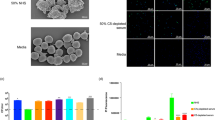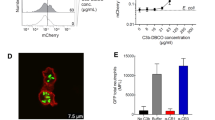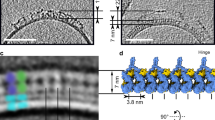Abstract
We describe the engineering of antibody fragments produced in bacteria for recruitment of complement effector functions. From a phage display repertoire we isolated human antibody fragments directed against complement C1q, and linked these to lysozyme-specific antibody fragments, creating bispecific antibodies (diabodies). One diabody was able to recruit C1q, resulting in efficient lysis of lysozyme-coated sheep erythrocytes, and also induced rosette-formation of erythrocytes with human monocytes and phagocytosis after phorbol ester stimulation. These diabodies may have therapeutic applications requiring the activation of complement.
This is a preview of subscription content, access via your institution
Access options
Subscribe to this journal
Receive 12 print issues and online access
$209.00 per year
only $17.42 per issue
Buy this article
- Purchase on Springer Link
- Instant access to full article PDF
Prices may be subject to local taxes which are calculated during checkout
Similar content being viewed by others
References
Winter, G., Griffiths, A.D., Hawkins, R.E., and Hoogenboom, H.R. 1994. Making antibodies by phase display technology. Annu. Rev. Immunol. 12: 433–455.
Duncan, A.R. and Winter, G. 1988. The binding site for C1q on lgG. Nature 332: 738–740.
Duncan, A.R., Woof, J.M., Partridge, L.J., Burton, D.R., and Winter, G. 1988. Localization of the binding site for the human high-affinity Fc receptor on IgG. Nature 332: 563–564.
Burton, D.R. and Woof, J.M. 1992. Human antibody effector function. Adv. Immunol. 51: 1–84.
Fanger, M.W., Morganelli, P.M., and Guyre, P.M. 1992. Bispecific antibodies. Crit. Rev. Immunol. 12: 101–124.
Fanger, M.W. and Guyre, P.M. 1991. Bispecific antibodies for targeted cellular cytotoxicity. Trends Biotech. 9: 375–380.
Holliger, P., Brissinck, J., Williams, R.L., Thielemans, K., and Winter, G. 1996. Specific killing of lymphoma cells by cytotoxic T-cells mediated by a bispecific diabody. Protein Eng. 9: 299–305.
Zhu, Z., Zapata, G., Shalaby, R., Snedecor, B., chen, H., and Carter, P. 1996. High level secretion of a humanized bispecific diabody from Escherichia coli. Bio/Technology 14: 192–196.
Cooper, N.R. 1985. The classical complement pathway: activation and regulation of the first complement component. Adv. Immunol. 37: 151–216.
Erdei, A. and Reid, K.B.M. 1988. The C1 q receptor. Mol. Immunol. 25: 1067–1073.
Guan, E.N., Burgess, W.H., Robinson, S.L., Goodman, E.B., McTigue, K.J., and Tenner, A.J. 1991. Phagocytic cell molecules that bind the collagen-like region of C1 q. Involvement in the C1 q-mediated enhancement of phagocytosis. J. Biol. Chem. 266: 20345–20355.
Holliger, P., Prospero, T.D., and Winter, G. 1993. “Diabodies”: small bivalent and bispecific antibody fragments. Proc. Natl. Acad. Sci.USA 90: 6444–6448.
Perisic, O., Webb, P.A. Holliger, P., Winter, G., and Williams, R.L. 1994. Crystal structure of a diabody, a bivalent antibody fragment. Structure 2: 1217–1226.
Kontermann, R.E., Martineau, P., Cummings, C.E., Karpas, A., Alien, D., Derbyshire, E., and Winter, G. 1997. Enzyme immunoassays using bispecific diabodies. Immunotechnology. In press.
Bobak, D.A., Gaither, T.G., Frank, M.M., and Tenner, A.J. 1987. Modulation of FcR function by complement subcomponent C1 q enhances the phagocytosis of IgG-opsonized targets by human monocytes and culture-derived macrophages. J. Immunol. 138: 1150–1156.
Bobak, D.A., Washburn, R.G., and Frank, M.M. 1988. C1q enhances the phagocytosis of Cryptococcus neoformans blastospores by human monocytes. J. Immunol. 136: 1023–1026.
Brown, E.J. 1991. Complement receptors and phagocytosis. Curr. Op. Immunol. 3: 76–82.
Tenner, A.J. and Cooper, N.R. 1982. Stimulation of a human polymorphonuclear leukocyte oxidative response by the C1q subunit of the first complement component. J. Immunol. 128: 2547–2552.
Oiki, S. and Okada, Y. 1988. C1q induces chemotaxis and K+ conductance activation coupled to increased cytosolic Ca2+ in mouse fibroblasts. J. Immunol. 141: 3177–3185.
Xia, M.Q., Tone, M., Packman, L., Hake, G., and Waldmann, H. 1991. Characterization of the Campath-1 (CDw52) antigen: biochemical analysis and cDNA cloning reveal an unusually small peptide backbone. Eur. J. Immunol. 21: 1677–1684.
Holliger, P., Wing, M., Pound, J.D., Bohlen, H., and Winter, G. 1997. Retargeting serum immunoglobulin with bispecific antibodie. Nature Biotechnology 15: 632–636.
Chatenoud, L., Ferran, C., Legendre, C., Thouard, I., Merite, S., Reuter, A., et al. 1990. In vivo cell activation following OKT3 administration. Systemic cytokine release and modulation by corticosteroids. Transplantation 49: 697–702.
Moreau, T., Coles, A., Wing, M., Isaacs, J., Hale, G., Waldmann, H., and Compston, A. 1996. Transient increase in symptoms associated with cytokine release in patients with multiple sclerosis. Brain 119: 225–237.
Wing, M.G., Moreau, T., Greenwood, J., Smith, R.M., Hale, G., Isaacs, J., et al. 1996. Mechanism of first-dose cytokine-release syndrome by Campath-H: Involvement of CD16 (FcgRIII) and CD11 a/CD18 (LFA-1) on NK cells. J. Clin. Invest. 98: 2819–2826.
Wing, M.G., Waldmann, H., Isaacs, J., Compston, D.A.S., and Hale, G. 1997. Ex-vivo whole blood cultures for predicting cytokine release syndrome: dependence on target antigen and antibody isotype. Ther. Immunol. In press.
Alegre, M.L., Collins, A.M., Pulito, V.L., Brosius, R.A., Olson, W.C. Zivin, R.A., et al. 1992. Effect of a single amino acid mutation on the activating and immunosuppressive properties of a "humanized" OKT3 monoclonal antibody. J. Immunol. 148: 3461–3468.
Alegre, M.L., Peterson, L.J. Xu, D., Sattar, H.A., Jeyarajah, D.R., Kowalkowski, K., et al. 1994. A non-activating “humanized” anti-CD3 monoclonal antibody retains immunosuppressive properties in vivo. Transplantation 57: 1537–1543.
Vaughan, T.J., Williams, A.J., Pritchard, K., Osbourn, J.K., Pope, A.R., Earnshaw, J.C., et al. 1996. Human antibodies with sub-nanomolar affinities isolated from a large non-immunized phage display library. Nature Biotechnology 14: 309–314.
Marks, J.D., Hoogenboom, H.R., Bonnert, T.P., McCafferty, J., Griffiths, A.D., and Winter, G. 1991. By-passing immunisation: human antibodies from V-gene libraries displayed on phage. J. Mol. Biol. 222: 581–597.
McGuinness, B.T., Walter, G., FitzGerald, K., Schuler, P., Mahoney, W.,, Duncan, A.R., and Hoogenboom, H.R. 1996. Phage diabody repertoires for selection of large numbers of bispecific antibody fragments. Nature Biotechnology 14: 1149–1154.
Author information
Authors and Affiliations
Rights and permissions
About this article
Cite this article
Kontermann, R., Wing, M. & Winter, G. Complement recruitment using bispecific diabodies. Nat Biotechnol 15, 629–631 (1997). https://doi.org/10.1038/nbt0797-629
Received:
Accepted:
Issue Date:
DOI: https://doi.org/10.1038/nbt0797-629
This article is cited by
-
Unlocking the Power of Complement-Dependent Cytotoxicity: Engineering Strategies for the Development of Potent Therapeutic Antibodies for Cancer Treatments
BioDrugs (2023)
-
A novel bispecific antibody platform to direct complement activity for efficient lysis of target cells
Scientific Reports (2019)
-
Therapeutic antibodies for human diseases at the dawn of the twenty-first century
Nature Reviews Drug Discovery (2003)
-
Happy coupling: Recruiting both antigen and effector function
Nature Biotechnology (1997)



